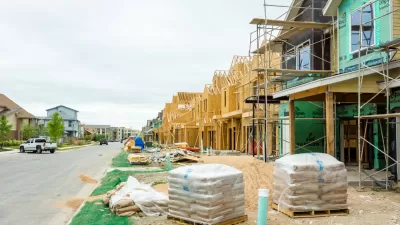Smart Growth critic Wendell Cox recently endorsed White House Economic Advisor Jason Furman's criticisms of zoning codes that limit infill development, essentially endorsing Smart Growth policy reforms.

In a recent blog, White House Economist Links Land Use Regulations: Housing Affordability and Inequality, Wendell Cox supports Smart Growth policies, although it is unclear whether he realizes this.
Cox bases his blog on an Urban Institute presentation by Jason Furman, Chair of the White House Council of Economic Advisers, titled, Barriers to Shared Growth: The Case of Land Use Regulation and Economic Rents, which highlights ways that, by limiting the supply of affordable urban infill, zoning codes reduce housing development, affordability and economic opportunity in attractive, economically-successful cities.
Cox is a vocal Smart Growth critic, often using what I believe is inaccurate evidence to argue that urban containment regulations are the primary cause of housing unaffordability, but Furman's presentation clearly indicates that zoning codes that discourage urban infill (e.g., minimum lot size, restrictions on building density and height, limits on multi-family housing, minimum parking requirements, and excessive development fees) are the primary factor driving up housing prices and reducing affordability in economically successful cities. As a result, Cox essentially endorses Smart Growth policies that reduce such regulations, although his blog fails to acknowledge this point.
Furman cites several studies that quantify these effects, such as Hsieh and Moretti's recent study, Why Do Cities Matter? Local Growth and Aggregate Growth, which estimates that zoning restrictions in New York, San Francisco, and San Jose reduce national economic productivity by 9.5 percent, or about $2 trillion; they also recommend that cities invest in high quality public transit, which Cox has frequently criticized. Furman cites Gyourko, Saiz, and Summers's study, A New Measure of the Local Regulatory Environment for Housing Markets: The Wharton Residential Land Use Regulatory Index (WRLURI), which quantifies land use regulations, almost all of which limit urban infill, and their tendency to increase housing prices (see table below). He cites Edward L. Glaeser and Bruce A. Ward's study, The Causes And Consequences Of Land Use Regulation: Evidence From Greater Boston, which shows that there is no overall shortage of urban land; rather, housing prices are driven up by restrictions on infill in attractive cities and suburbs. Furman also points out that changing consumer preferences are shifting demand toward more compact housing types and more multi-modal neighborhoods.
Wharton Regulatory Index Impacts
|
Index Component |
Development Impacts |
|
Local Political Pressure Index (LPPI). Degree of involvement by various local actors (local and county councils, community pressure groups, etc.) in residential development. |
Local political pressure tends to limit infill development, which encourages sprawl. |
|
State Political Involvement Index (SPII). Degree the state legislature affects residential development and growth management. |
Some state regulations reduce sprawl by protecting openspace (farms and natural lands) or imposing urban growth boundaries. |
|
State Court Involvement Index (SCII). The tendency of courts to uphold municipal land-use regulations including impact fees and exactions, fair share development requirements, building moratoria, and spot or exclusionary zoning. |
Depends on what regulations are challenged in courts. Since municipal policies tend to discourage infill development, stronger municipal rights tends to increase sprawl. |
|
Local Zoning Approval Index (LZAI). Number of organizations or regulatory bodies that must approve zoning changes. |
To the degree that local organizations oppose infill development, it tends to encourage sprawl. |
|
Local Project Approval Index (LPAI). Number of local entities that approve a project that did not require any zoning change |
Tends to discourage infill development and so encourages sprawl. |
|
Local Assembly Index (LAI).Whether a jurisdiction has direct democracy interventions, such as community meetings, that must approve zoning changes. |
Local residents tend to oppose infill development, so a higher rating tends to encourage sprawl. |
|
Supply Restrictions Index (SRI).Indicates explicit constraints or caps on new housing development. |
Discourages infill development, particularly lower-priced units, and so encourages sprawl. |
|
Density Restrictions Index (DRI). Existence of restrictions on density such as minimum lot size requirements. Over 80% of communities surveyed have such regulations. |
Tends to discourage infill development and so encourages sprawl. |
|
Open Space Index (OSI). Reflects whether home builders are subject to open space requirements. Over half (54%) of the communities surveyed report such a requirement. |
Tends to discourage infill development and so encourages sprawl. |
|
Exactions Index (EI). Indicates whether developers are required to pay a significant share of the infrastructure improvement costs associated with new development. |
Depends on how it is structured. If applied equally per unit, tends to discourage more affordable development. |
|
Approval Delay Index (ADI). Typical time between a rezoning or subdivision application and issuance of building permits. |
Indicates the difficulty of new development. |
The Wharton Residential Land Use Regulatory Index includes many components, most of which reflect pro-sprawl restrictions on compact infill development. Studies show that such restrictions tend to increase housing costs.
Cox and I have an ongoing debate about these issues. Last year I wrote a widely citied report, Analysis of Public Policies That Unintentionally Encourage and Subsidize Urban Sprawl, which Cox recently criticized in Putting People First: An Alternative Perspective with an Evaluation of the NCE Cities “Trillion Dollar” Report, and which I believe is full of inaccuracies, as discussed in, Response to Putting People First: An Alternative Perspective with an Evaluation of the NCE Cities “Trillion Dollar.
For example, Cox claims that sprawled cities, such as Phoenix, Houston, and Miami, are affordable due to their liberal land policies, and compact cities such as Boston, Seattle, and San Francisco are unaffordable due to their urban containment regulations, but that argument overlooks two key points. First, the cities he criticizes as unaffordable are all very attractive, economically successful, and geographically constrained, so their land is naturally scarce and expensive. Because such cities are limited in their ability to expand outward, housing affordability requires that they build upward by allowing higher density infill.
Second, cities' affordability rankings tend to reverse if transportation expenses are considered as well as housing expenses, as illustrated below. Cox's analysis is incomplete and biased because it considers housing costs alone, and so fails to recognize the much higher transport costs in sprawled locations.
Combined Housing and Transportation Costs By U.S. Cities

The compact regions that Cox criticizes as unaffordable, such as Boston, Seattle and San Francisco, have lower total housing and transport expenses than the sprawled regions he advocates, such as Phoenix, Houston and Miami, because their higher housing costs are more than offset by cheaper transport. (Consumer Expenditure Survey)
The data also contradict Cox's claim that pro-sprawl policies increase economic opportunity. Using data from the Equality of Opportunity Project, Ewing and Hamidi found that each 10 percent increase in their Smart Growth index is associated with a 4.1 percent increase in residents' upward mobility (the probability a child born in the lowest income quintile reaches the top quintile by age 30). In fact, the sprawled urban regions that Cox cites as examples to be emulated, such as Pittsburgh, Atlanta, Columbus, and Dallas, have far lower average incomes and higher poverty rates than the U.S. average, while the cities that he criticizes for their Smart Growth policies are very economically successful. Of course, many other factors besides local development policies may help explain these outcomes, but this certainly contradicts claims that low-density, automobile-dependent development increases productivity and opportunity. Described differently, Cox's prescription for housing affordability is to encourage poverty.
Income and Poverty Rates Compared

The sprawled urban regions that Cox cites as examples to be emulated have far lower average incomes and higher poverty rates than the U.S. average, while the cities that he criticizes for their Smart Growth policies are very economically successful.
A recent book, Zoned In The USA, by Professor Sonia Hirt (reviewed by Professor Michael Lewyn in American Dreams, American Realities) provides more good evidence that pro-sprawl policies are ineffective at increasing housing affordability and economic opportunity. Hirt compares zoning codes between different countries, which provides a natural experiment for testing their economic impacts.
Despite low urban densities, high automobile ownership, low fuel prices, and generous mortgage tax deductions, the United States has lower home ownership rates than peer countries: 65 percent of U.S. housing is owner-occupied, compared with 67 percent in Australia, 68 percent in Canada, and 70 percent for the European Union average. In addition, 45 percent of U.S. houses have a mortgage, compared with just 27 percent in the European Union, further indicating that sprawl-based policies that encourage lower-density urban-fringe development fail to increase home ownership. The major difference between the United States and other democracies is that a larger portion of Americans live in detached houses in lower-density, automobile-dependent neighborhoods, while other countries have more compact housing (e.g., rowhouses and multi-family) located in multi-modal neighborhoods, which tends to be more affordable overall, considering both housing and transport expenses.
Why do Americans live in larger but less affordable homes which lead to lower home ownership rates? Hirt argues that this results from restrictive policies such as zoning codes that prohibit more compact housing types on most urban residential land. According to her analysis, the overwhelming majority of residential land is reserved for single-family houses, and no U.S. city in which more than 3 percent of the land is zoned for mixed use. These regulations are far more restrictive than in European cities. For example, most of Paris has "General Urban" zoning which allows "a startling variety of establishments, including houses, apartment buildings, shops, restaurants, cafes and offices."
These restrictions on urban density and mix increase housing costs and motor vehicle travel, which has several measurable, undesirable outcomes: not only does the United States have significantly lower home ownership rates, it also has higher portion of household budgets devoted to transport, higher traffic fatality rates, higher obesity rates, and fewer transport options, and therefore less economic opportunity, for non-drivers. Described differently, Smart Growth policies provide numerous economic, social and environmental benefits.
The differences are equally stark when comparing communities within the United States, as discussed in my report. The compact regions that Cox criticizes as unaffordable, such as Boston, Seattle, and San Francisco, have lower total housing and transport expenses than the sprawled regions he cites as desirable examples, such as Phoenix, Houston, and Miami, because their higher housing costs are more than offset by cheaper transport. The sprawled regions also have significantly lower average incomes, higher poverty rates, lower education attainment, higher housing foreclosure rates, and less economic mobility than the compact regions he criticizes.
This makes sense because, compared with compact and multi-modal development, sprawl is more resource-intensive: it increases per capita land consumption, by dispersing destinations it increases the costs of providing public infrastructure and services, by reducing travel options it increases per capita motor vehicle travel and associated costs, and by reducing accessibility for non-drivers it reduces affordability and economic opportunity for physically and economically disadvantaged people. Those additional costs and barriers are inefficient and unfair.
This has important policy implications. Cox argues that the solution to high housing prices and low economic opportunity is simply more of the last century's pro-sprawl and pro-automobile policies: more urban expansion, more home ownership subsidies, lower vehicle ownership fees and fuel taxes, but he offers no evidence that such policies can really achieve their goals. On the contrary, both theoretical and empirical evidence indicate that pro-sprawl exacerbate these problems, and that Smart Growth policy reforms help solve them.
There is now good recent evidence that Smart Growth policies can increase housing affordability: According to a recent Puget Sound Business Journal article, Bad Timing: As Thousands Of New Apartments Open, Seattle's Rental Market Weakens, the large number of new, primarily multi-family housing units being developed in Seattle (7,400 in 2014, and 22,000 in 2015) are significantly reducing rents in one of North America's most attractive and economically successful cities. The article reflects the developers' perspective and so describes this as an undesirable threat, but this is good news for moderate-income households that want to live in Seattle and for businesses that depend on moderate-wage workers. Similarly, although Cox has criticized Vancouver, BC for its rising housing costs, this is only true of single-family housing, attached (townhouse) and multi-family housing prices have hardly increased, indicating that the city's policies to encourage compact development are at least partly successful at maintaining housing affordability, and are very successful at achieving other planning objectives such as transportation affordability and traffic safety. This and other research show that zoning code reforms that allow more compact, infill development can increase housing affordability and reducing homelessness.

Vancouver region single-family housing prices increased significantly during the last five years, but townhouse and apartment prices have been flat.
Smart Growth development policies are proven to provide several significant benefits including open space preservation, public infrastructure, and service cost efficiencies, increased accessibility, and modal diversity, which reduces transport costs and increases independence and economic opportunity for non-drivers, reduced chauffeuring burdens imposed on drivers, more affordable housing options (townhouses, apartments, accessary units, etc.), increased traffic safety, improved fitness and health, increased economic productivity, and reduced per capita fuel consumption and pollution emissions.
There are legitimate grounds for debating exactly where urban containment regulations are justified. Cox implies that they provide no benefits, while I believe that they are often justified, but they are of little importance overall since they are so uncommon. The urban containment regulations that Cox frequently criticizes only exist in a few urban regions, primarily in Oregon and British Columbia, while zoning regulations and development fees that discourage affordable infill development exist in nearly every North American city (even Houston). For every strongly-enforced urban containment regulation that limits urban expansion, there are dozens of regulations that limit urban infill. As a professed conservative and libertarian, Cox should support efforts to eliminate or reduce such regulations. Cox and I should agree on this.
I challenge Cox to provide credible evidence that the pro-sprawl policies he usually endorses actually increase overall (housing and transport) affordability and economic opportunity. Even better, I challenge him to more clearly endorse the policy reforms that researchers agree tend to increase housing affordability and economic opportunity, including increases in allowable density and building heights, allowing more compact (adjacent and multi-family) housing types, reduced and more flexible parking requirements, and reduced development fees for urban infill. Wendell, please clarify your position on pro-infill policies.

Coming Soon to Ohio: The Largest Agrivoltaic Farm in the US
The ambitious 6,000-acre project will combine an 800-watt solar farm with crop and livestock production.

Pennsylvania Mall Conversion Bill Passes House
If passed, the bill would promote the adaptive reuse of defunct commercial buildings.

U.S. Supreme Court: California's Impact Fees May Violate Takings Clause
A California property owner took El Dorado County to state court after paying a traffic impact fee he felt was exorbitant. He lost in trial court, appellate court, and the California Supreme Court denied review. Then the U.S. Supreme Court acted.

Dallas Surburb Bans New Airbnbs
Plano’s city council banned all new permits for short-term rentals as concerns about their impacts on housing costs grow.

Divvy Introduces E-Bike Charging Docks
New, circular docks let e-bikes charge at stations, eliminating the need for frequent battery swaps.

How Freeway Projects Impact Climate Resilience
In addition to displacement and public health impacts, highway expansions can also make communities less resilient to flooding and other climate-related disasters.
City of Costa Mesa
Licking County
Barrett Planning Group LLC
HUD's Office of Policy Development and Research
Mpact Transit + Community
HUD's Office of Policy Development and Research
Tufts University, Department of Urban and Environmental Policy & Planning
City of Universal City TX
ULI Northwest Arkansas
Write for Planetizen
Urban Design for Planners 1: Software Tools
This six-course series explores essential urban design concepts using open source software and equips planners with the tools they need to participate fully in the urban design process.
Planning for Universal Design
Learn the tools for implementing Universal Design in planning regulations.



























